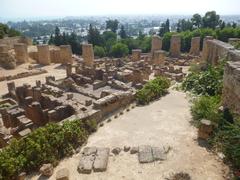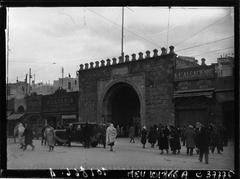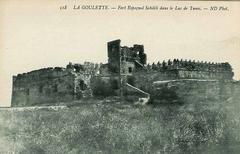Dar El Monastiri Visiting Hours, Tickets & Complete Guide to Tunis Historical Sites
Date: 04/07/2025
Introduction
Dar El Monastiri is one of the Medina of Tunis’s most distinguished historical residences, offering an immersive journey through Tunisia’s architectural, social, and cultural evolution. As a 19th-century palace that now serves as the National Center for Calligraphy, Dar El Monastiri stands at the crossroads of tradition and modernity. This comprehensive guide covers everything you need to know: visiting hours, ticketing, accessibility, guided tours, nearby attractions, and tips for making the most of your visit.
For detailed updates and official information, consult resources from the Tunisian Ministry of Culture and recognized travel guides (belle-tunisie.tn, Wikipedia, Lonely Planet).
Historical Overview
Dar El Monastiri was constructed in the early 19th century, during the reign of Mahmud Bey, and commissioned by his son, Hussein II Bey. The palace was later acquired by M’hamed El Monastiri, a prominent chaouachi (fez trader), whose family’s legacy is deeply embedded in the economic and social history of Tunis. Over time, the palace’s function evolved—serving as an institute of arts during the French protectorate, then as a craft education center, and, since 1990, as the National Center for Calligraphy (Wikipedia, Interference Project).
Architectural Highlights
Location and Urban Context
Situated at 9, rue El Monastiri in the UNESCO-listed Medina of Tunis, Dar El Monastiri is nestled among other historic homes, religious monuments, and bustling souks. Its proximity to landmarks such as the Sidi Mahrez Mausoleum and Zitouna Mosque makes it an ideal starting point for exploring the medina (belle-tunisie.tn).
Architectural Features
- Entrance: The palace’s grand entrance is framed in kadhal limestone and adorned with traditional ironwork, a symbol of status and protection (petitfute.com).
- Vestibules: A sequence of vestibules (driba and skifa) leads from the street to the central patio, ensuring privacy and gradual transition from public to private space.
- Central Courtyard: The heart of the dar is a spacious patio bordered by porticoes with arches and columns. This open-air nucleus ensures natural ventilation and light, and serves as the organizing axis for all rooms (belle-tunisie.tn).
- Room Typologies: The ground floor and upper story feature a mix of inverted T-shaped rooms and single chambers, with a kushk (small retreat) at the head of the staircase.
- Decorative Elements: Moucharabiehs (wooden lattice screens) line the upper floor, filtering light while preserving privacy. The palace is further embellished with stucco, tilework, and intricate ceilings.
- Adaptive Reuse: Ancillary structures, including a guest house and domestic outbuildings, have evolved with successive owners and uses, reflecting the palace’s adaptability (belle-tunisie.tn).
Visiting Information
Visiting Hours & Tickets
- Opening Hours: Typically open Tuesday to Sunday, 9:00 AM to 5:00 PM. Closed Mondays and public holidays. Some cultural events may affect hours; check ahead via the Interference Project or official tourism sites.
- Admission: Entry is generally free, but special exhibitions or workshops may require a nominal fee or advance booking.
- Guided Tours: Available by request through the National Center for Calligraphy or local operators. Booking in advance is recommended for in-depth experiences.
Accessibility & Facilities
- Physical Access: Due to steep staircases and uneven historical surfaces, accessibility is limited for those with mobility impairments. Some ground-floor areas are accessible, and assistance can be requested.
- Amenities: On-site restrooms, information panels, and shaded rest areas are available. The medina is best navigated on foot—comfortable shoes are highly recommended.
Travel Tips
- Dress Code: Modest attire is recommended out of respect for local customs.
- Language: Arabic and French are the main languages; basic French is helpful.
- Photography: Permitted, but ask permission during workshops or when staff are present.
- Best Time to Visit: Early morning or late afternoon for fewer crowds and better light for photography.
Cultural and Social Significance
Dar El Monastiri is more than an architectural marvel; it is a living center of Tunisian heritage. As the hub for Arabic calligraphy, it regularly hosts workshops, exhibitions, and cultural events. The palace’s layered history reflects the evolution of Tunisian society—from the chaouachi guild’s prosperity to contemporary cultural preservation efforts (Lonely Planet).
Nearby Attractions & Transportation
- Sidi Mahrez Mausoleum: A masterpiece of Ottoman architecture, just steps away.
- Zitouna Mosque: The spiritual and educational heart of the medina.
- Dar Lasram: Another historic residence, now serving as the headquarters for the Association de Sauvegarde de la Médina.
- Bardo Museum: Home to world-renowned Roman mosaics, a short taxi ride from the medina.
Getting There: Taxis and light rail bring visitors to the medina’s main gates (Bab el Bhar), with Dar El Monastiri a short walk away. Parking is limited; walking is the best way to explore the medina (backpackadventures.org).
Frequently Asked Questions (FAQ)
Q: What are Dar El Monastiri’s visiting hours?
A: Open Tuesday to Sunday, 9:00 AM–5:00 PM. Closed Mondays and public holidays.
Q: Is there an entrance fee?
A: Generally free; special events may require a small fee.
Q: Are guided tours available?
A: Yes, through the National Calligraphy Center or local operators.
Q: Is the site wheelchair accessible?
A: Accessibility is limited due to historic design; inquire ahead for details.
Q: Can I take photos?
A: Photography is allowed, but please ask during events or workshops.
Visuals and Interactive Media
- Images: High-quality photos of the grand entrance, patio, and artistic details.
- Alt text examples: “Dar El Monastiri entrance with traditional ironwork”, “Central courtyard of Dar El Monastiri”, “Moucharabieh screens at Dar El Monastiri”.
- Interactive Map: Pinpoints Dar El Monastiri and nearby attractions.
- Virtual Tours: Available on select heritage websites.
Responsible Tourism & Visitor Etiquette
- Respect the Site: Do not touch or lean on fragile decorative elements.
- Support Local Artisans: Purchase souvenirs from medina craft workshops.
- Sustainable Practices: Carry reusable water bottles and minimize waste.
Conclusion & Plan Your Visit
Dar El Monastiri is an essential stop for anyone seeking to understand Tunis’s layered history, architectural ingenuity, and vibrant cultural life. Its evolution from noble residence to cultural center mirrors Tunisia’s ongoing legacy of adaptation and creativity. Download the Audiala app for personalized guides, up-to-date schedules, and exclusive content on Tunisian heritage. Follow us on social media to stay informed and inspired.


